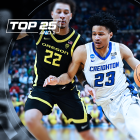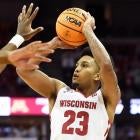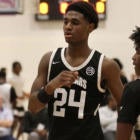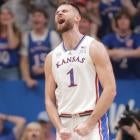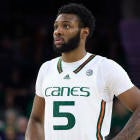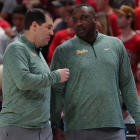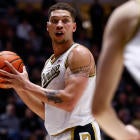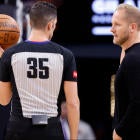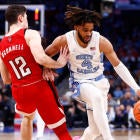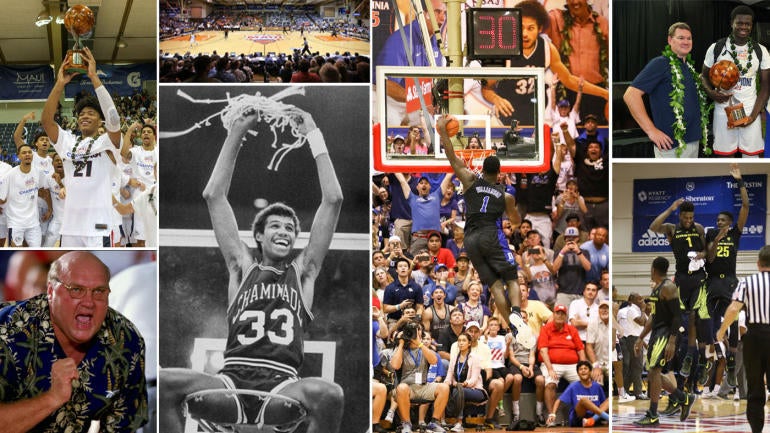
The 40th version of the Maui Invitational tips off Monday. It's one of my favorite events of the year, college basketball or otherwise.
Maui is worth celebrating every November, but especially this year, considering the milestone of the 40th edition and, with five of the eight teams being ranked, it's the most loaded field ever. More important than either of those things, however, is the somber backdrop of the Maui Invitational moving off the island of Maui for 2023 due to the wildfires that devastated Lahaina in August. Widespread recovery efforts are ongoing. The damage done will afflict the region for generations to come.
"The view of the devastation where the fire ripped through, it's jarring," ESPN college basketball analyst Jay Bilas told me.
Bilas, who's called more than 20 Maui tournaments, flew to Hawaii a few days early with some of his colleagues in an effort to survey the burn zone.
"Heartbreaking doesn't cover it," Bilas said. "There are no words to convey the feeling you have."
Given that much of Lahaina is an active FEMA recovery site with toxic chemicals still being removed, it obviously can't host a basketball tournament. A proud beachside community with roots and traditions that go back hundreds of years, much of the town was ravaged. Ninety-nine people were killed, according to the most recent published data. Many residents who evacuated still haven't been allowed back to see their charred homes. Some are living at nearby hotels.
Over 3,000 structures were destroyed by the fires. For those who escaped, so many of them still lost everything they had.
"I'm going to be 60 in December, and I've seen a few things. I don't think I've ever seen anything like that," Bilas said. "It was indescribable, the feeling you had seeing that, whether it was the burned-out cars or the storefronts on Front Street that you'd frequented … that had been there 150 years. Everything's gone. Melted steel, the I-beams: melted. The cars where the glass from the windshield had melted onto the steering column of the car, it looked like candle wax."

READ: Maui Invitational at 40: The 20 greatest games
Over the years, as the Maui Invitational became a defining feature of the college basketball season, its impact and significance as a proud civic tradition bolstered Lahaina. A three-day basketball party enhanced a town that was already on the list of the National Register of Historic Places long before they played hoops up on the hill where the Lahaina Civic Center became an iconic gym, something spiritually linked to the lead-up to Thanksgiving. This year, that spirit will carry on in Honolulu, on the island of O'ahu, at the University of Hawaii.
The competition and the celebration will continue; it's too important not to. From its humble beginnings, this is what the Maui Invitational means and how it became one of the venerated spectacles on the American sports calendar.
Chaminade's shocker sparks creation of Maui tournament
A bolt from the blue out in the mighty Pacific in 1982 offered up one of the most shocking scores in American sports history. The location of the game (Hawaii) in addition to college basketball entering its 1980s golden age made for something astonishing, a result that would elevate the sport — even as its best team suffered an all-time notorious defeat.
Dec. 23, 1982: Chaminade 77, No. 1 Virginia 72.
There's still a misnomer about that Chaminade shocker. Even after more than 40 years, some still mistakenly tie it to the early days of the Maui Invitational, but that isn't the case. No, that upset was a crack of thunder that catalyzed the idea to have Chaminade (an NAIA school at the time) host some big-time college teams near the start of every season.
Adding to the mystique was how few people saw the game. It wasn't televised, nor spread by videotape after the fact. As Sports Illustrated's Alexander Wolff would later dub it, Chaminade over Virginia was "the greatest upset never seen."
There were only a few hundred souls inside the University of Hawaii's Neal Blaisdell Center to watch the mighty Ralph Sampson get felled by a school essentially no one in the continental United States had ever heard of. With no Maui Invitational in existence in 1982, what was Virginia even doing playing Chaminade two days before Christmas?
Former Virginia coach Terry Holland was taking his team and his senior star/two-time national player of the year Ralph Sampson on a mini-world tour. Virginia flew to Japan to face Akeem Olajuwon and the daunting Houston Cougars on Dec. 16, then the University of Utah three days later. The Cavaliers won those two by a combined 32 points.
Why not stretch the legs and get some sunshine in Hawaii on the way back to the States? Virginia had played Chaminade years before, so here it was again, an 8-0 top-ranked team looking to get some calisthenics in against a school with an imaginative nickname: Silverswords. A forgotten fact of the time: Chaminade officials were in the midst of contemplating changing the name of the university. Beating Virginia ended all that.
As the story goes, Sampson was so sick he couldn't even play in Japan against Houston. In Hawaii, Sampson was feeling better. So, he played against Chaminade — adding to the mythology. When the upset went down, it was a faint speck of shock in the middle of the night, on an ocean island thousands of miles from the mainland. It would take a beat for word to spread and be aggregated in national newspapers.
A young reporter from the Washington Post named Michael Wilbon also happened to be on site for the game; he was only in Hawaii on assignment to cover Maryland football's bowl game. Against the advice of his editor, Wilbon covered Virginia's afterthought of a game, his story published on Christmas Day and became a defining narrative on the most stunning result college basketball had ever seen.

Dave Odom was an assistant on that 1982-83 Virginia team. (He's also the longtime chair of the Maui Invitational. Odom picks the matchups every year and determines future fields years in advance.) Years ago, he told me he remembered the arena not even being half-filled, despite Virginia's lofty perch in the sport at that time.
"When that happened, and people were so far removed from the mainland and what's really going on, it really helped college basketball," Odom told me. "Having a springboard like the Virginia game and the Louisville game, it awakened the island to the fact that college basketball and basketball as a sport was about to become a global entity, a global sport. If you leapfrog [ahead], anybody would say the two most global sports today are basketball and soccer. I would give Maui as much credit for that as anything."
Odom mentioned Louisville. Though it's not remembered like the Virginia conquest, Chaminade also beat top-15 Louisville under Denny Crum in 1983. Then did it again to the ranked Cardinals in 1984. Chaminade was for real. Soon enough, the Maui Invitational would be as well.
Ironically enough, years prior, Holland suggested to Chaminade athletic director Mike Vasconcellos that the school should host a basketball jamboree for Division I schools. A piercing irony: Holland's team losing in an infamous fashion gave credence to it finally happening.
Two years later, in 1984, it did. The first Maui Invitational wasn't even called the Maui Invitational — it wasn't even in Maui. Instead of eight teams, it had four. The "Silverswords Invitational" was held at a high school (Konawaena High School) on the Big Island of Hawaii in the town of Kealakekua. It moved to War Memorial Gym in Wailuku, on Maui, in 1985 and temporarily took on the "Maui Classic" banner. In 1987, with an eight-team field, it found its proper home: the Lahaina Civic Center.
The mythology and magic of Maui
Though it's bittersweet that this 40th version can't take place in Maui, it is all too appropriate that such a grand milestone features the best field of them all. With all due respect to the 1997 assembly that boasted No. 1 Arizona, No. 3 Duke and No. 8 Kentucky, there has never been a Maui bracket — or any MTE bracket — as stacked as this one. It's got the No. 1 team: Kansas. It's got the No. 2 team: Purdue. It's got Nos. 4 (Marquette), 7 (Tennessee) and 11 (Gonzaga). That's right: five of the eight are ranked — and undefeated UCLA just barely got knocked from the polls after being ranked last week. The other two are Syracuse, which is 10-0 all time in Maui games, and lovable Chaminade, which is based in Honolulu. This year, the Silverswords won't need to hop on a 25-minute flight to play. It's as much of a "home court" advantage as the school has ever experienced in the Invitational.
"I think it's the best MTE field ever," Gonzaga coach Mark Few told me as he prepared to board the team's flight to Honolulu. "I've never seen an eight-team field like this. You can win one game in this and still be a Sweet 16 team."
It's only fitting that all seven D-I schools landed in Hawaii without a loss to be seen, a combined 20-0 through the first two weeks of the season. If the Rose Bowl is the "granddaddy of them all" in college football, the Maui Invitational holds the same acclaim in college hoops. It's stood the test of time and only gotten better. Not even COVID could hold back this tournament.
Consider the evolution of scheduling as well.
Twenty years ago, early season tournament basketball consisted of Maui, the Great Alaska Shootout, the so-called "preseason NIT" and a couple other small events. Now there are more than two dozen MTEs in existence and the number seems to grow by the year.
Maui made that possible.
It's still the best of the bunch. Battle 4 Atlantis and others cull together some enticing fields, but year over year over year, the Maui Invitational still wins out way more often than not. It is the example by which all others are judged. It's the tournament that increased the excitement of Thanksgiving week in American sports.
We've had unforgettables such as Kentucky-Arizona in '92, Kerry Kittles and Nova in '95, Cinderella Ball State in '01. A few more: Gonzaga-Michigan State's 3OT epic in '05, shirtless Mike Brey in '17, Gonzaga giving Duke its first Maui loss ever in '18 and so many more.
There's something about Maui — daytime basketball, in bracket form, high-level teams, sometimes an underdog wins a game or two — that makes it a kindred spirit of March and the NCAA Tournament. You steal time during daylight hours to watch future NBA lottery picks and All-Americans, then fight off sleep late at night, lest you miss a Maui classic that wraps up somewhere close to 1:30 a.m. ET.
"I've been to a number of these MTEs early in the season, and there are so many really good ones, but all things considered, there's nowhere you'd rather be," Bilas said.
The winners on the wall in the Lahaina Civic Center tell so much of the story of college basketball, its kings and dynasties, most having passed through Maui on their way to forging championship fables. Per Maui officials, the event has hosted 129 schools from 26 leagues and 40 states since 1984. Past champions, all of them: Duke, North Carolina, Kentucky, UConn, Syracuse, Kansas, Michigan State, Indiana, UCLA, Illinois, Gonzaga, Villanova.
"It's not every year, but it seems like more often than not we're getting an Elite Eight or Final Four preview," Bilas said.

What happens there can serve as prophecy. UConn was a surprise 2010 champion; the Huskies would go on to win that national title later that season.
"Kemba in 2010, when they ripped through this tournament: I don't think anyone was sure how good UConn was," Bilas said. "He took over the whole season and that was a preview of what was coming."
The same happened for Michigan in 1988-89. North Carolina did the Maui-national title double dip thrice: 2004, 2008 and 2016. It's a semi-regular occurrence for at least one of the eight teams in the Maui field to make a Final Four later that season.
"It became the 'in' tournament for everyone to go to," former UConn coach Jim Calhoun told me years ago. "You'd get together, guys are really competitive, but it was also friendly. [There's] a lot of camaraderie, [it's] different than any other event in the sport."
Legends can be born here — and so can the fathers of legends. It's a Curry — Dell, not Steph — who holds the record for most field goals in a game (16). Adam Morrison's 43-point barrage in 2005 vs. Michigan State charted the course for winning a share of National Player of the Year that season.
"Special tourney, special place," Few said. "Some great memories."
What began in 1984 as a tiny four-team event in the middle of the Pacific Ocean has grown into an annual must-watch American sporting event, something that delivers drama and high-end matchups with regularity. When you turn on the TV in the middle of the day and see a Maui game happening, it signals the holiday season is officially upon us.
"The atmosphere comes through the TV set and that's not true everywhere," Bilas said.
You can build a case around the idea that November is the strongest month on the sports calendar. Even though it plays a small part, college basketball and the Maui Invitational undeniably factors into that. Daytime ball is comfort food for the hoops-loving soul. Without Maui, college basketball would feel a little less important in its first three weeks of the season.
Forty years in, Maui is stronger than ever. It's such a perfect thing for this sport that one of the greatest events with the biggest programs that grew into a behemoth was only made possible by a Little Guy pulling off a huge upset. That's college basketball.
Maui Invitational results
| Year | Champion | Runner-up | Score | Dr. Sue Wesselkamper MVP |
| 2022 | No. 9 Arizona | No. 10 Creighton | 81-79 | Oumar Ballo, Arizona |
| 2021 | Wisconsin | Saint Mary's | 61-55 | Johnny Davis, Wisconsin |
| 2020 | No. 17 Texas | No. 14 North Carolina | 69-67 | Matt Coleman III, Texas |
| 2019 | No. 4 Kansas | Dayton | 90-84 (OT) | Devon Dotson, Udoka Azubuike, Kansas |
| 2018 | No. 3 Gonzaga | No. 1 Duke | 89-87 | Rui Hachimura, Gonzaga |
| 2017 | No. 13 Notre Dame | No. 6 Wichita State | 67-66 | Matt Farrell, Notre Dame |
| 2016 | No. 4 North Carolina | No. 16 Wisconsin | 71-56 | Joel Berry II, North Carolina |
| 2015 | No. 5 Kansas | No. 19 Vanderbilt | 70-63 | Wayne Selden, Frank Mason III, Kansas |
| 2014 | No. 3 Arizona | No. 15 San Diego State | 61-59 | Stanley Johnson, Arizona |
| 2013 | No. 8 Syracuse | No. 18 Baylor | 74-67 | C.J. Fair, Syracuse |
| 2012 | Illinois | Butler | 78-61 | Brandon Paul, Illinois |
| 2011 | No. 6 Duke | No. 14 Kansas | 68-61 | Ryan Kelly, Duke |
| 2010 | UConn | No. 8 Kentucky | 84-67 | Kemba Walker, UConn |
| 2009 | Gonzaga | Cincinnati | 61-59 (OT) | Steven Gray, Matt Bouldin, Gonzaga |
| 2008 | No. 1 North Carolina | No. 8 Notre Dame | 102-87 | Ty Lawson, North Carolina |
| 2007 | No. 13 Duke | No. 11 Marquette | 77-73 | Kyle Singler, Duke |
| 2006 | No. 5 UCLA | No. 19 Georgia Tech | 65-63 | Darren Collison, UCLA |
| 2005 | No. 3 UConn | No. 8 Gonzaga | 65-63 | Adam Morrison, Gonzaga |
| 2004 | No. 11 North Carolina | Iowa | 106-92 | Raymond Felton, North Carolina |
| 2003 | Dayton | Hawaii | 82-72 | Keith Waleskowski, Dayton |
| 2002 | No. 19 Indiana | Virginia | 70-63 | Bracey Wright, Indiana |
| 2001 | No. 1 Duke | Ball State | 83-71 | Mike Dunleavy, Duke |
| 2000 | No. 1 Arizona | No. 8 Illinois | 79-76 | Michael Wright, Arizona |
| 1999 | No. 4 North Carolina | No. 22 Purdue | 90-75 | Joseph Forte, North Carolina |
| 1998 | No. 19 Syracuse | No. 17 Indiana | 76-63 | Jason Hart, Syracuse |
| 1997 | No. 3 Duke | No. 1 Arizona | 95-87 | Steve Wojciechowski, Duke |
| 1996 | No. 2 Kansas | Virginia | 80-63 | Raef LaFrentz, Kansas |
| 1995 | No. 3 Villanova | No. 20 North Carolina | 77-75 | Kerry Kittles, Villanova |
| 1994 | Arizona State | No. 7 Maryland | 97-90 | Mario Bennett, Arizona State |
| 1993 | No. 5 Kentucky | No. 13 Arizona | 93-92 | Travis Ford, Kentucky |
| 1992 | No. 1 Duke | BYU | 89-66 | Bobby Hurley, Duke and Anfernee Hardaway, Memphis |
| 1991 | Michigan State | No. 2 Arkansas | 86-71 | George Gilmore, Chaminade |
| 1990 | No. 13 Syracuse | No. 8 Indiana | 77-74 | Billy Owens, Syracuse |
| 1989 | No. 11 Missouri | No. 7 North Carolina | 80-73 | Doug Smith, Missouri |
| 1988 | No. 3 Michigan | No. 4 Oklahoma | 91-80 | Glen Rice, Michigan |
| 1987 | No. 11 Iowa | Villanova | 97-74 | Entire Iowa Team, Iowa |
| 1986 | Vanderbilt | New Mexico | 87-71 | Will Perdue, Vanderbilt |
| 1985 | No. 3 Michigan | Kansas State | 80-58 | Dell Curry, Michigan |
| 1984 | Providence | Chaminade | 60-58 | Patrick Langolis, Chaminade |
Note: AP ranking at time of Maui Invitational is listed













